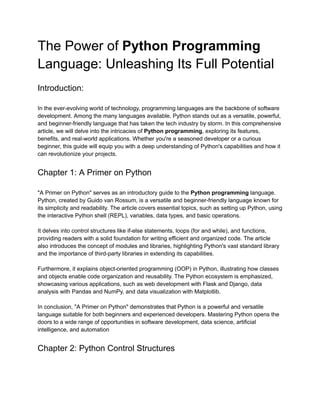
# **Reasons to Begin Your Python Learning Journey Now**
Are you searching for a method to simplify your life and make it more enjoyable? Look no further than Python! Not the creature, but the programming language. Python’s popularity is soaring, captivating both seasoned experts and newcomers all over the globe. It is celebrated for its clarity, adaptability, and proficiency in managing vast datasets seamlessly. With Python, you can automate your routine tasks, conduct data analysis, or even create your own web applications.
Continue reading to learn the top three reasons to kickstart your Python learning adventure today!
—
## **1. Python Is Simple and Quick to Master**
Python is frequently lauded for its straightforward and clear syntax. In contrast to programming languages such as Java or C++, Python enables you to write fewer lines of code while attaining equivalent outcomes. This characteristic makes Python easier to comprehend, write, and troubleshoot, making it perfect for novices and seasoned developers alike.
### **Example: Displaying “Hello, World!”**
Here’s a comparison of a simple case where Java and Python are used to print “Hello, World!”:
**Java:**
“`java
public class Greeting {
public static void main(String[] args) {
System.out.println(“Hello, World!”);
}
}
“`
**Python:**
“`python
print(“Hello, World!”)
“`
It’s evident that the Python version is far more succinct and accessible for beginners. This ease of use allows students to concentrate on solving problems without the distraction of convoluted syntax.
Additionally, Python is extensively utilized across various sectors, reinforcing its significance and demand. Let’s explore how different domains implement Python.
—
## **2. Python’s Versatility – Embraced by Diverse Industries**
Python is more than just a language for enthusiasts; it possesses tangible applications across multiple industries. Whether your interests lie in web development, data analysis, artificial intelligence, or cybersecurity, Python has significant applications.
### **Web Development**
Python offers frameworks like **Django** and **Flask** that streamline the web development process. High-profile websites such as Netflix, Instagram, and Spotify depend on Python for their backend systems. Specifically, Django assists developers in creating secure and scalable applications, featuring built-in capabilities like authentication and database management.
> **Netflix on Python**:
> “At Netflix, developers are encouraged to select technologies best suited to their tasks. Increasingly, they are opting for Python as it boasts a comprehensive standard library, clear syntax, a large community of developers, and a vast array of third-party libraries.”
### **Data Analysis**
Python is a vital asset for data scientists and analysts. Tools like **Pandas** and **NumPy** enable users to effectively manipulate significant datasets. Furthermore, visualization libraries such as **Matplotlib** facilitate the creation of meaningful charts and graphs.
A popular application for Python in data analysis is **web scraping**, which entails extracting valuable information from websites. Frameworks such as **Scrapy** and **BeautifulSoup** allow businesses to gather market insights or monitor consumer trends.
For instance, Twitter serves as a treasure trove for public sentiment analysis. Using Python along with **Tweepy**, organizations can analyze tweets about their products and services, empowering them to make well-informed marketing choices.
Here’s a straightforward Python script for retrieving tweets:
“`python
import tweepy
# Steps for developer authentication
consumer_key = “your_consumer_key”
consumer_secret = “your_consumer_secret”
access_token = “your_access_token”
access_token_secret = “your_access_token_secret”
# Create an authentication object
auth = tweepy.OAuthHandler(consumer_key, consumer_secret)
auth.set_access_token(access_token, access_token_secret)
# Create the API object
api = tweepy.API(auth)
# Search for tweets mentioning a company
query = “Toptal”
language = “en”
results = api.search(q=query, lang=language)
for tweet in results:
print(tweet.user.screen_name, “Tweeted:”, tweet.text)
“`
This script retrieves and displays tweets regarding a specific company, illustrating how Python can be effectively used in real-world contexts.
### **Artificial Intelligence (AI) & Machine Learning (ML)**
Python stands at the forefront of programming languages for AI and ML, thanks to its user-friendliness and comprehensive support for mathematical computations. Industries utilize AI to enhance features like recommendation engines, voice-activated assistants, and autonomous vehicles.
Notable Python libraries for AI and ML include:
– **TensorFlow** – Utilized for deep learning and neural networks.
– **Scikit-learn** – Offers simple and effective tools for data mining and machine learning.
– **Keras** – A high-level API for neural networks built on TensorFlow.
Since AI and ML entail processing extensive data volumes, Python’s efficiency and rich libraries position it as the preferred option for developers and researchers.
—
## **3. Promising Career Prospects with Python**
The need for Python expertise is rising, especially in tech-centric fields like data science, AI, and web development.
### **Job Demand**